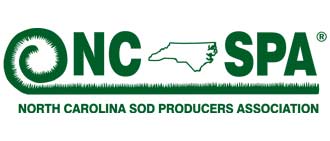The invention of big roll sod harvesters in 1991 was a big step in being able to provide thick, stable sod from farm to field. Slab and small roll versions were available before then, but a 42” or larger width roll really helped reduce the number of seams and allowed a more mechanized installation. Some of the problems include finding a good sod source and a farm willing to harvest thick cut. It is hard to convince a sod grower to change his cutting depth and truck off their most valuable resource (topsoil) in order to provide a field manager with heavy thick sod. Also, sod must be very mature and tightly knitted to hold together in a thick cut application, so planning a year in advance is necessary to secure a source.
Once the sod arrives at the field, there can be other problems. The thicker the sod is harvested at the farm, the bumpier it feels on the field. Also, if the farm native soil has high clay content, and you place over a drainage system, vertical drainage can be negated. When it does rain, the result can be a muddy, unstable surface. So the challenge became to develop a sod with a smooth uniform thickness, dense root system, a vertically draining root zone, and withstand 300 pound guys digging in with their cleats.
We are actually not sure who came up with the idea of growing sod on plastic. It sounded crazy at first when we heard of a company in Georgia growing bentgrass on plastic for golf greens. The product was about ½” thick and basically looked like a grass floor mat. From there we heard of versions of sod grown on plastic being used for some NFL teams as opposed to traditional thick cut, but supplies were scarce, if non-existent. In 2009 Carolina Green Corp., was asked by The University of Virginia to provide a full field replacement following an in-season U2 concert. The damaged stadium field was replaced following the concert and ready for immediate play (to view time-lapse video of field replacement go to our Time-Lapse Archive and click on UVA Stadium Turf Replacement). We opted to partner with a sod farm to produce that field, and from there developed GameOnGrass™, a sand-based bermuda sod system designed for immediate play situations.
The Root Bound Effect
The basic principal in sod grown on plastic is exhibited in a pot-bound plant. When you pull the plant out of a container after it has been there too long, all you see is a mass of roots that can hardly be broken. The same thing happens with mature sod grown on plastic. The roots have nowhere to go and as a result form a dense mat. Topdressing is used to build the sod layer up to desired thickness. With GameOnGrass™, we aim for 1.5” thickness which provides approximately 17 pounds per square foot total weight. One important characteristic of GameOnGrass™ is that we use sand base sod as an initial base, and then add topdressing sand typical for sand base construction, therefore producing a sod that vertically drains and can be left in the field profile without impeding vertical drainage or contaminating the profile.
Not Just a Short-Term Solution
In growing this market we have had to overcome the perception that sod on plastic was a product that would have to be removed and replaced with regular cut sod after the “emergency” was over. Since most installations were in the fall/winter months, questions were raised if the grass would survive and root into the field the following year once the bermuda breaks dormancy. This was probably the experience with early thick cut products with heavy soils and much less total root mass. What we have found in all cases is that GameOnGrass™ is the best grass on campus the following spring. It is thicker, greener, and quicker to break dormancy, and usually makes the grass beside it look inferior. The ability to control the rootzone profile of GameOnGrass™ seems to be the difference both short term and long term with performance and survivability. In fact, a mid-field replacement in football practice field situation can usually be effective for an entire year cycle, making the additional cost more justifiable.
Compare Costs
No doubt GameOnGrass™ is more expensive than regular cut or thick cut sod, possibly anywhere from 2 to 3 times the cost. Freight costs are three times that of traditional sod due to weighing at least 3 times that of traditional sod. The material and labor inputs at the farm are intense. Imagine growing anything on plastic in the summer with 1.5” soil layer. Not much margin for error, and no holiday time. So does that make it just an NFL product?
Here are some cost justifications we hear from customers. It keeps the field open year round for practice and play. In a situation where there is no additional space or no down time in the program, they can remain open with just a few hour delay. They already have significant investment in a facility with lights, parking, bathrooms and such, so why not utilize the facility to maximum potential? It is the same argument used for considering synthetic turf. The alternative is build additional fields, go synthetic, provide fewer programs, all of which cost money. Compare the cost of a new synthetic field with an 8 year replacement schedule to annual replacement with GameOnGrass™ down the center of the field along with additional goal mouth and lacrosse crease replacement. Then ask your players what surface they would prefer to play on throughout the year.
Another Tool
This is not an answer to all situations, just a consideration. But having an alternative resource for intense use natural grass field with minimal down time is a tool every field manager needs in the bag. The key to incorporating GameOnGrass™ into a turf management program is to plan ahead and secure a source. The supply of sod grown on plastic is limited. You will need a good prep and install plan for handling the turf. The equipment is similar to traditional sod replacement, but the added weight to move and manipulate the product creates an additional challenge. Removing turf from a field a few days before a big game involves a significant level of trust in the sod supplier and in the installer. For smaller projects such as goal mouths, installing GameOnGrass™ in-house is a good option. Just remember if you are bringing in 1.5”, you need to remove 1.5”. That is a lot of soil.
Break Out The War Paint - Unique Applications
In December 2011, WFI Stadium Inc. (FedEx Field) was faced with the task of logo replacement between games when they hosted the annual Army Navy Game less than 24 hours before hosting the NE Patriots. The solution? Paint the sod before its harvested. This had to be an historic first in the field replacement industry. The sod for the Redskins' game was pre-painted before being cut, transported and then installed. Prior to the install, Redskins Grounds crew came to Carolina Green's Sod Farm in Indian Trail, NC to paint the midfield logo and end zones for the Redskins-Patriots game. The sod was harvested, each roll numbered and logged, then transported to FedEx Field to await install. Management elected to replace the in-field logos between the games and leave the Army-Navy end zones in tact as a tribute to the armed services. After the NFL game the end zones were replaced with the pre-painted GameOnGrass™ as well.



